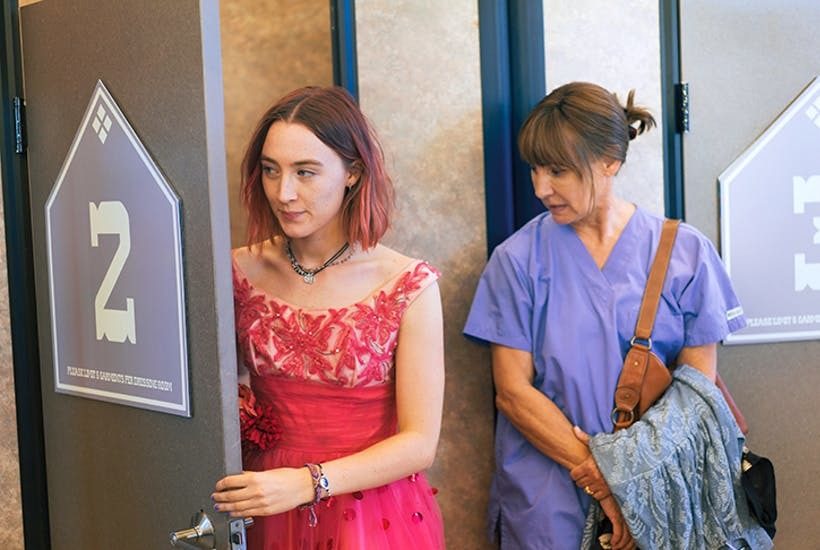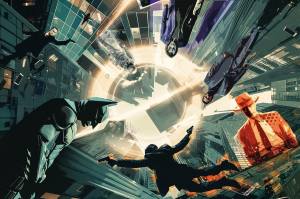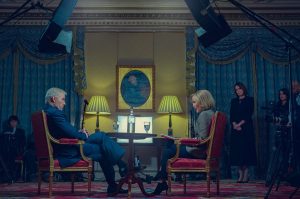Lady Bird
is a semi-autobiographical film written and directed by Greta Gerwig with a plot synopsis that need not detain us as it is basically only this: girl has a mum. (Or: girl has a mum, and sometimes they row and sometimes they don’t.) But thus far it has won near universal critical praise, two Golden Globes and five Oscar nominations, thereby proving there is mileage in girls and their mums, and box office in girls and their mums, and that girls and their mums can be more than mere afterthoughts. In this respect, Lady Bird may, in fact, be quite the rare bird.
It’s set in Sacramento, California, in 2002, and follows a year in the life of 17-year-old Christine McPherson, who calls herself ‘Lady Bird’ because she is, you know, At That Age. (I called myself ‘Debee’ At That Age.) She is played by Saoirse Ronan who was wonderful in Brooklyn and is as wonderful here. (She can carry emotional weight lightly, as if it were the most natural thing in the world.) The year is recounted via a series of vignettes as Lady Bird attends her Catholic high school, attends the school dances (one of the nuns patrols the dance floor, separating couples with the edict ‘six inches for the Holy Spirit!’), dates boys, loses her virginity (sit on that, Holy Spirit!), applies for colleges, ditches her best friend for a ‘better’ one, attempts to hide her modest background, and so on. An ordinary, uneventful life, except that it is full of event, as ordinary lives are when you bother to look properly. But through it all, and at the heart of it all, it is: girl has a mum. Whom she sometimes rows with and sometimes doesn’t.
Her mother, Marion, is played by Laurie Metcalf, who is also wonderful, and has been wonderful ever since she played Jackie in Roseanne all those moons ago. She works double shifts as a psychiatric nurse now that Lady Bird’s father (Tracy Letts) has lost his job. Marion can be mean and harsh and critical, and her relationship with her daughter is volatile — during one fight, Lady Bird even jumps out of a moving car. But you understand, as Lady Bird does, that while they’re both too similar to make nice, there is much love, and they do share some warm, joyful moments, as when they go about their favourite pastime, which is posing as prospective buyers and visiting fancy properties for sale. No one is just one thing, because none of us are. Here, Lady Bird is bold, smart, funny, vulnerable, but also self-important, disloyal, contemptuous and super-annoying. This is a coming-of-age story that’s affecting without ever being sentimental, and feels absolutely true — like remembering the teenager you once were, even if you were never a Lady Bird (or Debee) exactly. A rare bird indeed.
And on to The Shape of Water, the latest film from Guillermo del Toro, which has won two Golden Globes and has received 13 Oscar nominations, which means I should probably have liked it more than ‘girl has mum’. Set in America in 1962, during the height of the Cold War, this is a fairy tale starring Elisa (Sally Hawkins) as a mute cleaner who works at a high-security government laboratory that is housing a creature discovered in the Amazon. The creature, listed as ‘Amphibian Man’ in the credits, has a humanoid form but its insides are on the outside and he’s green and scaly and has a fishy head with huge eyes. He is kept chained in a tank by a sadistic government official (Michael Shannon) who likes to sizzle him with his electrified cattle prod, and who must prevent the Russians from stealing him at any cost. But Elisa understands; understands what it is to be lonely and crave affection and have no voice. She feeds Amphibian Man eggs and teaches him sign language and there is love and also… ahem… aqua erotica. Bit odd, but each to their own.
It’s visually delicious. The sets are lavish and meticulous and of this world, but always suffused with a sea green, which offers the sense of an oceanic world and, yes, the shape of water. But whereas Lady Bird was blissfully non-didactic, this tells you what to think and how to think it, going at what it wants to say as if with a jackhammer. Is it the monster who is the monster here, or the humans? (Yeah, yeah.) Shouldn’t we embrace those that are ‘other’ rather than be fearful? (Yeah, yeah.) In del Toro’s best film, Pan’s Labyrinth, which may be a masterpiece, he managed to weave the Spanish civil war cleverly into a fairy tale, but here the Cold War simply amounts to cartoonish, evil Russians bumbling around. It is intentionally flooded with other films (like Creature from the Black Lagoon), yet feels reminiscent of others (from King Kong to ET). I liked it well enough, but not as much as I should have. Girls having mums. That’s where it’s at.


















